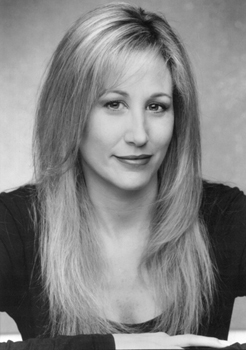
Hilary Helstein
After years of working with the USC Shoah Foundation and running the Los Angeles Jewish Film Festival, Hilary Helstein admits she still couldn’t make sense of the Holocaust. But through art, she found her way in – and so have audiences around the world who have watched her film As Seen Through These Eyes.
Helstein was one of the original interviewers for the Shoah Foundation, conducting over 250 testimonies all over the world. She specialized in hard-to-reach interviewees, traveling to remote areas of the West Coast to interview Holocaust survivors, witnesses and liberators including members of the Varian Fry rescue mission, a Chief of Staff of the US Army, and a “Mengele twin.” She also interviewed prominent subjects including Simon Wiesenthal and Nobel Prize recipient Walter Kohn.
She also conducted interviewer training sessions in Australia and performed “quality assurance” by reviewing around 300 completed testimonies and giving feedback to the interviewers.
Though her family was not connected to the Holocaust (except for two cousins her grandmother told her about), Helstein said through her work with the Shoah Foundation she discovered her passion for learning about it.
“I became obsessed with learning as much as I could about it – all these stories,” Helstein said.
In 2006, Helstein helped found the Los Angeles Jewish Film Festival and still serves as its executive producer. The week-long event celebrates diverse Jewish cultures through American and international films.
At about the same time, Helstein began making a documentary film of her own about the Holocaust, As Seen Through These Eyes. The film started out as an attempt for her to make sense of the Holocaust through something she had always known: art.
“I grew up in a family of artists so art is something I always understood. [I wanted to] to express the stories [of survivors] through a means that is understood universally,” Helstein said. “You look at a painting and it doesn’t matter what language you speak, what country you live in, what century you live in. You look at a painting and it creates an emotion within you. You feel something.”
Helstein began filming exhibitions of art created by Holocaust survivors and interviewed the artists themselves about how and why they made their art. How did they find their materials? Did they do it by choice or were they forced to create the art? How had they managed to protect their work during the war?
Notable examples are Karl Stojka, a Gypsy boy who worked for Josef Mengele and made over a thousand paintings of his experiences, and Dina Gottliebova Babbitt, who Mengele forced to paint portraits of Gypsies. Samuel Bak started painting in the Vilna Ghetto at age nine and survived the Holocaust partly because of his recognition as a child prodigy.
For the survivors who made art after the war was over, Helstein found that for many of them it was a way to “purge” the horrifying memories and experiences. It was a form of therapy and for some, a way to remember those lost.
But all the artists have something in common: their desire to continue with their work despite the odds stacked against them.
“What I learned was that for the artists it was a form of resistance, rebellion and escape. This was the way they fought the Nazis – through pencils and paintbrushes,” Helstein said. “It was the one thing the Nazis could not take away from them: their ability to think and create freely.”
As Seen Through These Eyes has been screened all over the world, and Helstein said people from all walks of life are moved by it.
One group of high school students in New York watched the film and were fascinated by Stojka, she remembered, because he looked like them. As soon as he came onscreen, the students were riveted. “When it was over, the questions were just firing at me. They couldn’t get enough. They wanted to know what happened to [the survivors in the film],” Helstein said. The teachers then facilitated a discussion with the students about how they had also used art or music to get themselves through a tough time.
A group of students in Berlin who watched the film also remarked that learning about young Holocaust survivors made the Holocaust “raw” and relatable for them for the first time – even though they are constantly studying it in school.
“All these are things I didn’t anticipate would come out of making this film, but I’m happy it’s reached people and I hope it will continue to reach people because these stories are important,” Helstein said.